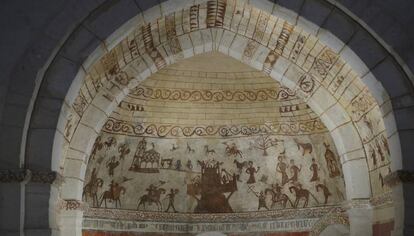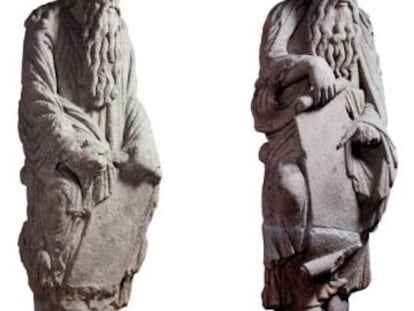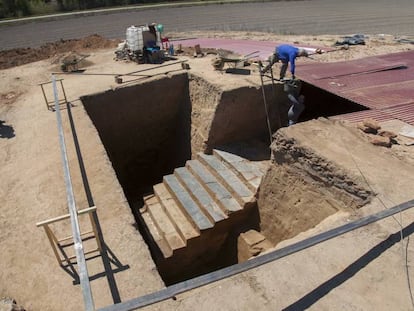Rape and war mural in Spanish church baffles historians
Art experts trying to get to the bottom of disturbing paintings discovered in Álava in 1985

A number of knights and warriors are attacking a castle; a small man throws himself onto a church bell while women carrying cups are depicted alongside deer and a number of strange beings intent on exposing themselves. Shift your gaze and you will see a Sagittarian centaur at a funeral, a woman giving birth and another who looks about to be raped.
“The paintings inside Alaitza church in Álava [Basque Country] are like a comic strip,” says José Javier Lópex de Ocariz, lecturer at Spain’s National Distance Education University (UNED) and Doctor of History at the École des Hautes Études in Paris. “But a libertarian comic strip painted in the 14th century in a Romanesque church,” he adds, pointing out one of the many incongruities of the paintings discovered beneath the altarpiece under a layer of lime 35 years ago.
All the researchers who have seen the paintings agree that they are strange, irreverent and don’t make senseIsabel Mellén, art historian
On November 10, a group of medieval art experts, including Ernesto Pastor, Fernando Sánchez Aranaz and López de Ocariz – professors from the University of the Basque Country – will gather in the town of Azilu to grapple with some of the secrets behind the complex, violent and lascivious narrative so inconsistent with the Christian message at a seminar sponsored by the Provincial Council of Álava.
According to philosopher and art historian Isabel Mellén from the company Medieval Álava, “all the researchers who have come here and who have seen the paintings agree that they are strange, irreverent and don’t make sense.”
The frescoes were painted using a very simple flat technique reminiscent of silhouetting in monochrome reddish-brown. Many of the characters appear to be wearing masks and are bearing weapons such as crossbows, which would be more typical of the 12th century. What appear to be three pilgrims from the Camino de Santiago, carrying cross-topped staffs, find themselves on the sides of the apse next to knights on horseback bearing standards.
Adding to the conundrum, the small rural church is less than four kilometers from the Gazeo church, which has nothing of this imagery. The mural that covers the chancel of Gazeo featuring the Trinity above a terrible depiction of hell and the condemned is more in line with the Gothic period, says López de Ocariz, despite its special iconography. The paintings at Alaitza, on the other hand, are totally removed from the context and iconography of the era. “They escape classification according to the established periods,” says Mellén.
The problem is that the content of this inscription does not correspond to the content of the frescoesJosé Javier Lópex de Ocariz, historian
There have been attempts to link the images, which have more to do with the pre-Romanesque period, to a particular event in the area’s history, such as the trek through the Álava Plains by the army of Eduardo The Black Prince – son of Edward III of England – in 1367, accompanied by King Pedro 1 on the eve of the battle of Nájera against Enrique de Trastámara.
But, according to López de Ocariz, it’s hard to believe that some of the soldiers who stayed in the area for no longer than a month would decorate the church. Meanwhile, French medieval historian Jean Froissart says that the soldiers in the Álava Plains would have been busy tending to their basic needs rather than painting churches.
Adding to the mystery is an incomplete inscription in Latin just below the mural, written in Gothic script. “The inscription is written in two parts,” says López de Ocariz. “The first coincides with a liturgical text, part of a hymn to Corpus Christi and the other warns of ‘hell all around’. The problem is that the content of this inscription does not correspond to the content of the frescoes.”
López de Ocariz jokes that the easiest things would have been for the painter to have explained his work alongside his signature. “It is like a summer news broadcast 650 years ago,” he says. “And I say summer, because all the wars took place at that time of year.”
English version by Heather Galloway.
Tu suscripción se está usando en otro dispositivo
¿Quieres añadir otro usuario a tu suscripción?
Si continúas leyendo en este dispositivo, no se podrá leer en el otro.
FlechaTu suscripción se está usando en otro dispositivo y solo puedes acceder a EL PAÍS desde un dispositivo a la vez.
Si quieres compartir tu cuenta, cambia tu suscripción a la modalidad Premium, así podrás añadir otro usuario. Cada uno accederá con su propia cuenta de email, lo que os permitirá personalizar vuestra experiencia en EL PAÍS.
¿Tienes una suscripción de empresa? Accede aquí para contratar más cuentas.
En el caso de no saber quién está usando tu cuenta, te recomendamos cambiar tu contraseña aquí.
Si decides continuar compartiendo tu cuenta, este mensaje se mostrará en tu dispositivo y en el de la otra persona que está usando tu cuenta de forma indefinida, afectando a tu experiencia de lectura. Puedes consultar aquí los términos y condiciones de la suscripción digital.
More information
Archived In
Últimas noticias
Maduro pleads not guilty before the federal court in New York: ‘I am still the president of Venezuela’
A new test can detect Alzheimer’s from a finger prick
UN team enters Sudanese city of El Fasher after paramilitary massacre: ‘It’s like a ghost town’
A recipe for resistance: Indigenous peoples politicize their struggles from the kitchen
Most viewed
- Gilles Lipovetsky: ‘If you want to live better and fall in love, take Prozac, don’t look to philosophy’
- Alain Aspect, Nobel laureate in physics: ‘Einstein was so smart that he would have had to recognize quantum entanglement’
- Maduro’s downfall puts China’s relationship with Venezuela to the test
- Why oil has been at the center of Venezuela-US conflicts for decades
- Alvin Hellerstein, a 92-year-old judge appointed by Bill Clinton, to preside over Maduro’s trial in New York











































